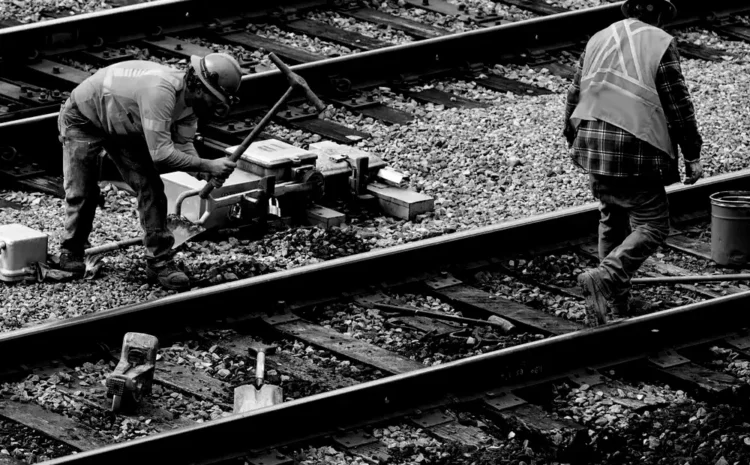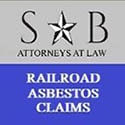
Asbestos, once hailed as a miracle material for its heat resistance and durability, has left a legacy of illness and legal battles in its wake, particularly among railroad employees. The law firm of Sammons & Berry, P.C., with its deep commitment to defending the rights of workers exposed to hazardous materials, understands the gravity of asbestos-related diseases and the importance of seeking justice for those affected. This blog post aims to shed light on the significant risks railroad employees faced before 1982 due to asbestos exposure, the various ways this exposure occurred, and the ongoing efforts to seek compensation and justice for the victims.
Asbestos exposure has been a critical health issue for individuals who worked in the railroad industry before 1982. During this time, asbestos was widely used in numerous applications due to its fire-resistant and insulating properties. Unfortunately, the dangers of asbestos were not as well known or were often ignored, placing countless workers at risk for developing serious, life-threatening illnesses, such as mesothelioma, lung cancer, and asbestosis.
Railroad employees were particularly vulnerable to asbestos exposure through several key avenues. First, asbestos was commonly used in the insulation of steam locomotives. The engineers, firemen, and other workers who operated and maintained these locomotives were at a high risk of inhaling asbestos fibers, especially during repairs or when insulation material degraded. These fibers, once inhaled, could become lodged in the lining of the lungs, leading to inflammation, scarring, and, eventually, the development of malignant cells.
Another significant source of asbestos exposure was through the brake shoes on trains. Asbestos-containing materials were used in brake pads and linings for their durability and resistance to heat. During maintenance or replacement of these components, dust containing asbestos fibers could be released into the air and inhaled by workers, posing a severe health risk over time.
Furthermore, asbestos was also found in the buildings and facilities where railroad employees worked. Many of these structures contained asbestos in their construction materials, including roofing, flooring, and insulation. Disturbances to these materials during renovations, repairs, or even daily activities could release asbestos fibers into the environment, increasing the risk of exposure for everyone in the vicinity.
The law firm of Sammons & Berry, P.C., emphasizes that the consequences of asbestos exposure can take decades to manifest, with many individuals only developing symptoms years after their initial exposure. This delayed onset makes it challenging for victims to connect their illness with their work environment, complicating their fight for justice and compensation.
Recognizing these challenges, Sammons & Berry, P.C., is dedicated to supporting railroad workers and their families in their legal battles. The firm’s expertise in asbestos litigation means they understand the complexities of these cases, including the need to gather comprehensive evidence and navigate the legal hurdles that often stand in the way of victims receiving the compensation they deserve.
For those affected, the fight against asbestos-related diseases is not just a personal battle; it’s a matter of public health and workplace safety. The legacy of asbestos exposure in the railroad industry underscores the importance of strict safety regulations and the need for employers to protect their workers from hazardous materials.
Representation for Second Hand Asbestos Exposure
At Sammons & Berry, P.C., our commitment to advocating for victims of asbestos exposure extends beyond those directly exposed in their workplaces. We recognize that asbestos-related illnesses can also profoundly affect individuals through secondhand exposure, a reality faced by many families of railroad employees. This blog aims to elucidate how secondhand exposure occurs, particularly through sharing vehicles or handling laundry, and the legal avenues available for those affected to seek justice and compensation.
Asbestos-related diseases, once thought to be confined to workers in direct contact with the material, have increasingly been diagnosed in individuals who were exposed indirectly. This form of exposure happens when asbestos fibers are brought home on the clothing, skin, hair, or personal items of those who worked in contaminated environments. Family members of railroad employees, who worked prior to the strict regulation of asbestos in the early 1980s, are at a particularly high risk. The intricate details of how secondhand exposure occurs highlight the insidious nature of asbestos and the importance of legal expertise in navigating these complex cases.
Sharing Vehicles with Railroad Workers
One common pathway for secondhand exposure was through sharing vehicles with railroad employees. Workers often traveled to and from job sites in company or personal vehicles while wearing their work clothes, which could have been contaminated with asbestos fibers. These microscopic fibers could easily become embedded in the vehicle’s upholstery, floor mats, and air filtration systems, only to be disturbed and become airborne later, posing a risk to anyone who used the vehicle. Family members sharing these vehicles could inhale or ingest asbestos particles, unknowingly putting themselves at risk for developing the same serious health conditions as those with direct exposure.
Doing Laundry for Railroad Employees
Another significant source of secondhand exposure was the handling of contaminated clothing. It was not uncommon for family members to wash the work clothes of those who worked on or around trains. Shaking out the clothes before washing them, or even the agitation during the washing process, could release asbestos fibers into the home environment. These fibers could remain airborne for hours, making inhalation likely. They could also settle on household surfaces, clothing, and even in the fabric of the home, further increasing the risk of exposure for the entire family.
The Legal Challenges of Second Hand Asbestos Exposure
The legal landscape for second hand asbestos exposure cases is complex and requires a nuanced understanding of both asbestos litigation and the specific circumstances of each case. Victims of secondhand exposure face several unique challenges, including proving the source of their exposure and linking it to a specific entity, such as a railroad company. The nature of secondhand exposure means that there may be no direct employment relationship with the company responsible for the asbestos contamination, complicating the legal process.
Sammons & Berry, P.C., specializes in overcoming these challenges. Our team possesses deep knowledge and experience in asbestos litigation, including secondhand exposure cases. We understand the burden of proof required and have developed strategies to gather the necessary evidence to support our clients’ claims. This includes detailed documentation of the diagnosed condition, expert testimony on asbestos exposure and its health effects, and evidence linking the exposure to the railroad employee’s work environment.
Our firm is dedicated to ensuring that all victims of asbestos exposure, whether direct or secondhand, receive the justice and compensation they deserve. We believe in holding responsible parties accountable for their negligence in handling asbestos and in supporting the health and well-being of affected individuals and their families.
Asbestos exposure’s reach extends beyond the workplace, affecting families and communities in profound ways. Sammons & Berry, P.C., stands at the forefront of addressing the consequences of both direct and secondhand asbestos exposure. Through our legal expertise and compassionate approach, we aim to provide a voice for the voiceless and a path to justice for those suffering from asbestos-related diseases. It’s not just a legal battle; it’s a fight for the health and future of families impacted by asbestos.
At Sammons & Berry, P.C., we specialize in providing a free Asbestos Exposure Consultation across the United States, offering a no-cost, no-obligation consultation to discuss your case’s facts without any upfront fees. Asbestos trust claims, importantly, do not necessitate a lawsuit, depositions, or court appearances, streamlining the process to be straightforward and client-friendly, ensuring it remains free from any stressful legal confrontations. Our law firm takes on the responsibility of managing all claims, dedicating ourselves to helping you secure the maximum possible compensation.
We operate strictly on a contingent fee basis, meaning our payment is a percentage of the compensation you receive. This ensures our interests are aligned with yours – to maximize your claim. Notably, if we do not succeed in obtaining compensation for you, you will incur absolutely no cost.
To embark on your path towards rightful compensation without any financial risk, call us today at (800) 519-1440. A representative from Sammons and Berry, P.C. is ready to assist you, ensuring personalized guidance throughout the entire process. Trust us to stand by your side, leveraging our extensive expertise to navigate the complexities of asbestos claims, all while you focus on your well-being.
Wrongful Death Claims For Families of Asbestos Victims
If you have lost someone in your family due to the harmful exposure of asbestos, you may be entitled to compensation. If you can provide the work history and a death certificate for your loved one, our attorneys can help you file an asbestos claim. We understand how difficult this process can be, this is why we work with you every step of the way to help you get the money you deserve. Reach out to our team today to learn more about filing a claim for a family member.
See if you qualify for compensation
Sammons & Berry, P.C.
800-519-1440
View our Google Listing
View our Facebook


